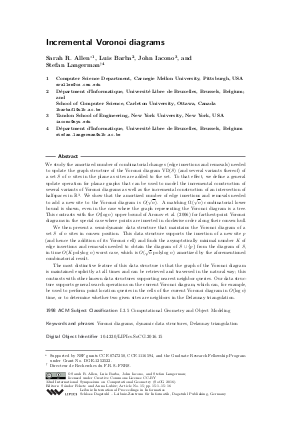Incremental Voronoi diagrams
Authors Sarah R. Allen, Luis Barba, John Iacono, Stefan Langerman
-
Part of:
Volume:
32nd International Symposium on Computational Geometry (SoCG 2016)
Part of: Series: Leibniz International Proceedings in Informatics (LIPIcs)
Part of: Conference: Symposium on Computational Geometry (SoCG) - License:
 Creative Commons Attribution 3.0 Unported license
Creative Commons Attribution 3.0 Unported license
- Publication Date: 2016-06-10
File

PDF
LIPIcs.SoCG.2016.15.pdf
- Filesize: 0.61 MB
- 16 pages
Document Identifiers
Subject Classification
Keywords
- Voronoi diagrams
- dynamic data structures
- Delaunay triangulation
Metrics
- Access Statistics
-
Total Accesses (updated on a weekly basis)
0PDF Downloads0Metadata Views
Abstract
We study the amortized number of combinatorial changes (edge insertions and removals) needed to update the graph structure of the Voronoi diagram VD(S) (and several variants thereof) of a set S of n sites in the plane as sites are added to the set. To that effect, we define a general update operation for planar graphs that can be used to model the incremental construction of several variants of Voronoi diagrams as well as the incremental construction of an intersection of halfspaces in R^3. We show that the amortized number of edge insertions and removals needed to add a new site to the Voronoi diagram is O(n^(1/2)). A matching Omega(n^(1/2)) combinatorial lower bound is shown, even in the case where the graph representing the Voronoi diagram is a tree. This contrasts with the O(log(n)) upper bound of Aronov et al. [Aronov et al., in proc. of LATIN, 2006] for farthest-point Voronoi diagrams in the special case where points are inserted in clockwise order along their convex hull. We then present a semi-dynamic data structure that maintains the Voronoi diagram of a set S of n sites in convex position. This data structure supports the insertion of a new site p (and hence the addition of its Voronoi cell) and finds the asymptotically minimal number K of edge insertions and removals needed to obtain the diagram of S U (p) from the diagram of S, in time O(K polylog n) worst case, which is O(n^(1/2) polylog n) amortized by the aforementioned combinatorial result. The most distinctive feature of this data structure is that the graph of the Voronoi diagram is maintained explicitly at all times and can be retrieved and traversed in the natural way; this contrasts with other known data structures supporting nearest neighbor queries. Our data structure supports general search operations on the current Voronoi diagram, which can, for example, be used to perform point location queries in the cells of the current Voronoi diagram in O(log n) time, or to determine whether two given sites are neighbors in the Delaunay triangulation.
Cite As Get BibTex
Sarah R. Allen, Luis Barba, John Iacono, and Stefan Langerman. Incremental Voronoi diagrams. In 32nd International Symposium on Computational Geometry (SoCG 2016). Leibniz International Proceedings in Informatics (LIPIcs), Volume 51, pp. 15:1-15:16, Schloss Dagstuhl – Leibniz-Zentrum für Informatik (2016)
https://doi.org/10.4230/LIPIcs.SoCG.2016.15
BibTex
@InProceedings{allen_et_al:LIPIcs.SoCG.2016.15,
author = {Allen, Sarah R. and Barba, Luis and Iacono, John and Langerman, Stefan},
title = {{Incremental Voronoi diagrams}},
booktitle = {32nd International Symposium on Computational Geometry (SoCG 2016)},
pages = {15:1--15:16},
series = {Leibniz International Proceedings in Informatics (LIPIcs)},
ISBN = {978-3-95977-009-5},
ISSN = {1868-8969},
year = {2016},
volume = {51},
editor = {Fekete, S\'{a}ndor and Lubiw, Anna},
publisher = {Schloss Dagstuhl -- Leibniz-Zentrum f{\"u}r Informatik},
address = {Dagstuhl, Germany},
URL = {https://drops.dagstuhl.de/entities/document/10.4230/LIPIcs.SoCG.2016.15},
URN = {urn:nbn:de:0030-drops-59079},
doi = {10.4230/LIPIcs.SoCG.2016.15},
annote = {Keywords: Voronoi diagrams, dynamic data structures, Delaunay triangulation}
}
Author Details
References
-
Greg Aloupis, Luis Barba, and Stefan Langerman. Circle separability queries in logarithmic time. In Proceedings of the 24th Canadian Conference on Computational Geometry, CCCG'12, pages 121-125, August 2012.

-
Boris Aronov, Prosenjit Bose, Erik D Demaine, Joachim Gudmundsson, John Iacono, Stefan Langerman, and Michiel Smid. Data structures for halfplane proximity queries and incremental Voronoi diagrams. In LATIN 2006: Theoretical Informatics, pages 80-92. Springer, 2006.

-
Luis Barba. Disk constrained 1-center queries. In Proceedings of the 24th Canadian Conference on Computational Geometry, CCCG'12, pages 15-19, August 2012.

-
Jon Louis Bentley and James B Saxe. Decomposable searching problems i. static-to-dynamic transformation. Journal of Algorithms, 1(4):301-358, 1980.

-
P. Bose, S. Langerman, and S. Roy. Smallest enclosing circle centered on a query line segment. In Proceedings of the 20th Canadian Conference on Computational Geometry (CCCG 2008), pages 167-170, 2008.

-
Timothy M Chan. A dynamic data structure for 3-d convex hulls and 2-d nearest neighbor queries. Journal of the ACM (JACM), 57(3):16, 2010.

-
Yi-Jen Chiang and Roberto Tamassia. Dynamic algorithms in computational geometry. Proceedings of the IEEE, 80(9):1412-1434, 1992.

-
Mark De Berg, Marc Van Kreveld, Mark Overmars, and Otfried Cheong Schwarzkopf. Computational geometry. Springer, 2000.

-
Herbert Edelsbrunner and Raimund Seidel. Voronoi diagrams and arrangements. Discrete &Computational Geometry, 1(1):25-44, 1986.

-
Rolf Klein. Concrete and Abstract Voronoi Diagrams, volume 400 of Lecture Notes in Computer Science. Springer, 1989.

-
Rolf Klein, Elmar Langetepe, and Zahra Nilforoushan. Abstract voronoi diagrams revisited. Computational Geometry, 42(9):885-902, 2009.

-
Mark H Overmars. The design of dynamic data structures, volume 156. Springer Science &Business Media, 1983.

-
Seth Pettie. Applications of forbidden 0–1 matrices to search tree and path compression-based data structures. In Proceedings of the Twenty-First Annual ACM-SIAM Symposium on Discrete Algorithms, pages 1457-1467, 2010.

-
Daniel D Sleator and Robert Endre Tarjan. A data structure for dynamic trees. Journal of Computer and System Sciences, 26(3):362-391, 1983.

